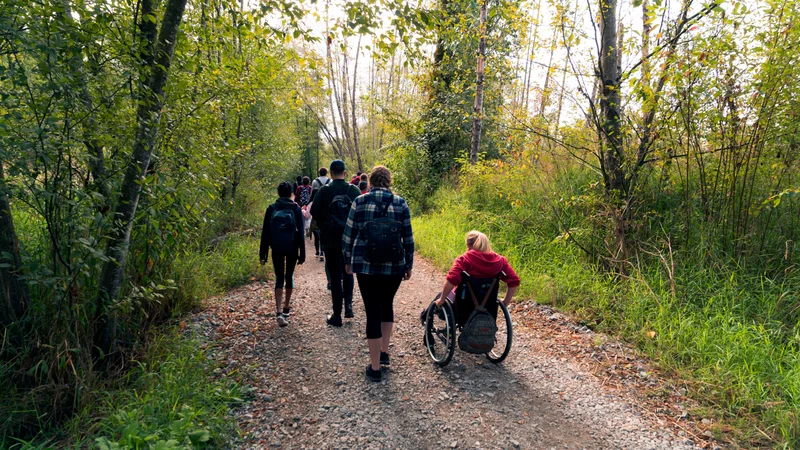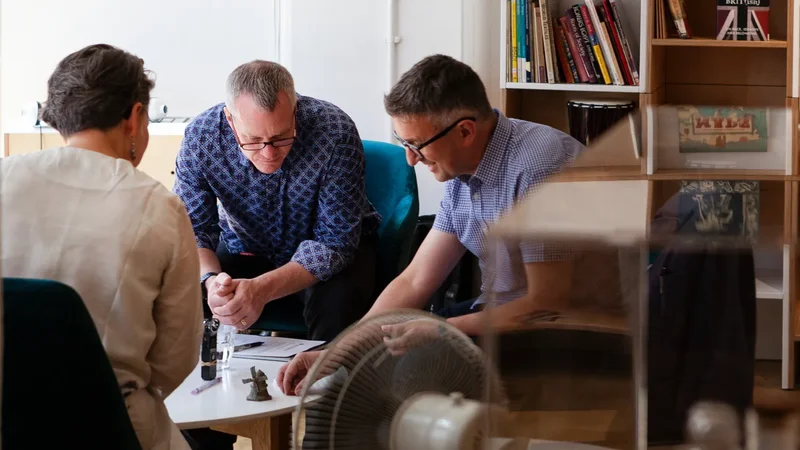Facilitating the complexity and difficulty of emotional situations that arise in group and community contexts requires deep skills in navigating intricate behavioural patterns and intense group dynamics. It involves balancing emotional neutrality with heightened self-awareness. These situations demand a sophisticated understanding of individual and group responses, especially when personal biases and deep-rooted frustrations surface. The approach described below is self-directed, emphasizing empathy and self-regulation in the face of challenging, emotionally charged scenarios, with minimal expert intervention. This nuanced process underscores the intricate nature of resolving emotional conflicts and fostering positive group interactions.
Ideally, this material should be accompanied by professional training, consistent practice, and a perspective of ongoing skill development.
Phase One — 90% of all situations
This phase emphasizes self-awareness and self-regulation, as facilitators focus on being emotionally centred and neutral. They observe behavioural patterns and cultivate discussions that develop empathy. This phase addresses the participant's interaction with their environment and has the goal of making small nudges in healthy directions.
Start: Take the time to be centred, emotionally neutral, and not activated. Do your personal homework (which never ends). Notice your own activation and follow it to what it can teach you.
Notice: The “vibe” — patterns of behaviour, intensity, discomfort, cliques, isolation, etc. Pay particular attention to your own habits of conflict, evasion, or bullying; resolve them.
Do: Facilitate short (5-10 minutes) and private discussions. Be receptive, generous, empathic, and self-questioning. Avoid judgment, blaming, or advice-giving. Instead, notice and be curious.
Say: Use your language, but use it effectively:
- “I notice…”
- “I’m glad about…”
- “I’m curious about…”
- “I’m wondering if…”
- “What do you think?”
- “Can we meet halfway?”
Use the language of diplomacy. Let the participant blend with the group. Avoid special treatment or focus. Treat everyone equally.
If you think it will help, make an informal contract (it can — and probably should — be verbal rather than documented).
Be internally supportive; find something to like about everyone with whom you work. Always return to your own center. Trust in the process.
Be subtle (i.e. private) and supportive. Check in, notice improvements, and stay connected. Be positive but not partial.
If you have made a contract, give it a few days to solidify (no more than a week), then check in. Build belonging, trust, and emotional safety.
Remember:
- Act soon. Don't wait for dynamics to evolve. Step in at the first moment you see something that requires attention. (Almost all critical incidents happen because facilitators wait too long before acting.)
- Emotional safety is foundational. Ensure that discussions don't trigger emotional distress or overwhelm.
- Group dynamic health determines personal outcomes. Avoid the formation of cliques or social isolation.
- There is a risk of harm to participants or others when behaviours get out of hand. Preventing these negative outcomes is the primary role of the facilitator.
Phase Two — more difficult scenarios (8% more)
In this phase, addressing personal frustrations and biases involves a deeper level of self-awareness for the facilitator. Private discussions and verbal contracts demonstrate unique solutions and self-direction. Strategic feedback is focused on maintaining neutrality and curiosity.
Start: Issues and behaviors persist. The contract (if you made one) has not worked. Notice and deal with your own frustration. Approach the participant without bias or blame. Think about how you might get activated by this situation – and don’t do it. Maintain a collaborative approach. Resolve your own activation, take responsibility for errors you might have made, and move forward positively.
Notice: Persistent behavior impacts everyone. The behaviour may or may not be intentional (people are complex; sometimes it can be impossible to know what they intend). Recognize that your activation is the primary danger. Take time to breathe, go slow, and prepare. Think about what you might have missed.
Do: Take the participant aside again, privately. Be receptive and firm. Use the Columbo approach — if you know who that is! If not: stay neutral, friendly, and curious. Set aside your own judgment. Above all, avoid punitive postures or approaches.
Say: Pay attention to your voice tone and body language. These factors communicate more than your words do. In turn, your words should be consistent with your voice tone and body language:
- “I want to check in…”
- “I notice…”
- “I’m curious…”
- “Help me understand.”
- “We need to work on it.”
- “Boundaries and safety are for everyone.”
- “This is how we do this as a community that works together.”
- “Here's what I need... Can we do that?”
If you feel that it would be helpful, you could revisit and revise the (verbal) contract you made in the previous step (phase one).
Remember:
- There is potential harm when participants share trauma (as they often do, at this stage). Be cautious with sensitive personal stories.
- Group dynamic health is the main factor that impacts the progress of individual participants in group programs. Be consistent in navigating persistent behaviours that affect the group negatively (meeting with specific participants before and/or after each group session, for example). Facilitation involves much more than "running a group": it's also (and as much) about what happens before, after and between group sessions.
- Emotional safety only happens when participants feel a sense of belonging, and they cannot feel belonging or emotional safety if they are subject to facilitator bias or frustration.
Phase Three — the most difficult situations (the remaining 2%)
This most challenging phase is focused on handling contract failures and shifting to a conditional approach. There's a delicate balance here between the ongoing encouragement of empathy and self-awareness while also recognizing group dynamics and personal frustrations.
Start: Your efforts have not been successful. The participant has ignored or defied the contact (if you made one). The participant is unable or unwilling to change their behaviour (they might not know, and you may not know, which of these it is). At this point you are ready to kick the participant out — but try not to do this until you have made one final set of efforts.
Don’t “take it to the group” for community feedback — don't ever do this. It is your responsibility (not the group's) to assist participants in their engagement and participation with your program. Much harm can result from situations in which untrained participants give unconstrained feedback to one another. Don't contribute to those risks. Instead:
Notice: Your frustration and the group's dynamics. Everyone is increasingly affected. The group dynamics have begun to damage or corrode belonging, trust, and safety (Remember, it’s only 2%.)
Do: Share your frustration with the participant privately. Shift from a collaborative approach to a conditional approach that reflects basic requirements for participation (which they may not be able or willing to meet). Whenever possible, encourage and facilitate decision-making and autonomy for the participant (e.g. “You can stay if you decide that you can meet the guidelines; or, if you decide that you can't, let's find another program that better suits your needs”).
Say: You can show a bit of frustration here — you're a person, after all, and you've been impacted by this just like everyone else. You've also put in quite a bit of fruitless effort. So, it's fair to share a small amount of those feelings with the participant — but sharing anger would be going too far. Strong feelings such as anger, derision, aggression, and so on are for you to work out on your own, with support from others in your own life (colleagues, clinical supervisors, and other professionals — not friends) and with the aim of understanding where these feelings come from (hint: your own childhood) and how they emerge in these kinds of situations with participants. And, of course, if you can understand where strong feelings might come from, and you can be aware of their emergence in moments of stress with participants, you can then reduce the risks to yourself (and everyone else) by learning to manage these feelings more effectively.
Use strategic language:
- “I’m not sure what else to do…”
- “You need to decide what is going to work for you, but this is the bottom line of what I need…”
- “Here's what I'll do if I see the behaviour again.” (Non-aggressive, proactive intervention: a hand raised* in the group to stop a participant from talking, a verbal reminder in the moment, a private chat.)
- “If you depart, I will still support you.”
*The raising of a hand to stop someone from speaking is a complex and highly consequential skill. If done improperly, such a gesture can be interpreted as everything from an insult to an assault. If done properly, a raised hand is a respectful reminder of previously agreed-upon behaviours and assistance in following them.
At this stage, you might need some help from colleagues or a supervisor. If that's the case, don't wait. As always, be proactive. Most of the harms in group settings can be avoided or minimized when facilitators act early, consistently, and with purpose.
Remember:
- The facilitator must manage their own emotions as well as those of participants.
- Participants can assist one another in managing emotional activation, but they cannot assist the facilitator. As a facilitator, you must manage yourself.
- The expression of strong negative feelings toward participants is a red flag that signals to the facilitator an urgent need to do some personal self-awareness work.
Facilitating groups is among the most complex tasks that one can undertake. It's hard. It requires consistent practice. But it can also be learned. We can practice and get better. When we do so, group work can become a source of deep play, joy, and meaning.
“I find that the best way to clear up these little matters is to talk about them.”
For information about workshops and training offered by Ross Laird, please visit this page or contact Ross directly.



